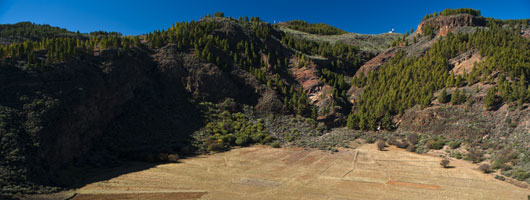La Caldera de Los Marteles can be seen from this slope which is less than 1,000,000 years old. This formation, approximately 80m deep and 550 m across, is actually the result of a reasonably explosive phreatomagmatic eruption (when lava came into contact with underground water).

At this point, the brightest sun can give way to the thickest fog in a matter of minutes on clear days, caused by the condensation of clouds on the humid windward hillside, transforming it on the downwind side, (called the Föhn, or Foehn effect). The prevailing vegetation is made up of replanted Canary pine trees, highland heather, sage, knapweed and blueweed. At the bottom of the Caldera (crater) lie geometric ploughing patterns, as this was a traditional farming area.
The landscape surface features many trails and paths etched out of the hillside, which meander in all directions, with glimpses on the northern side of the Roques de Tenteniguada and the well-known Roque Grande and, if the trade winds allow it, La Isleta and the city of Las Palmas de Gran Canaria.
